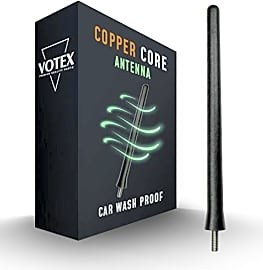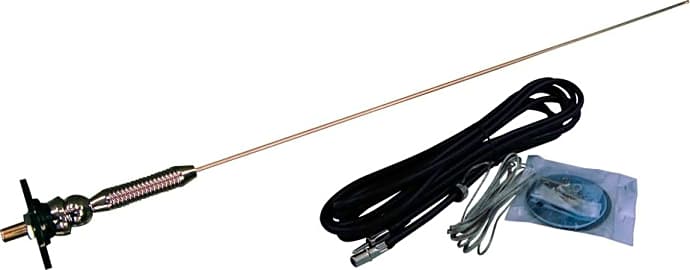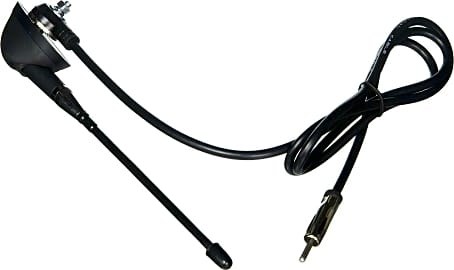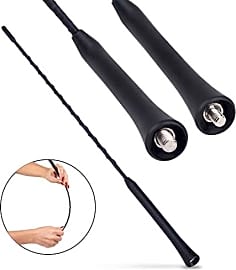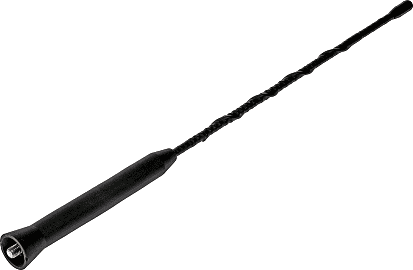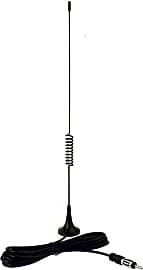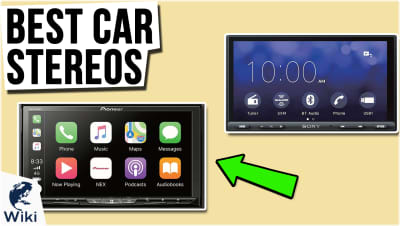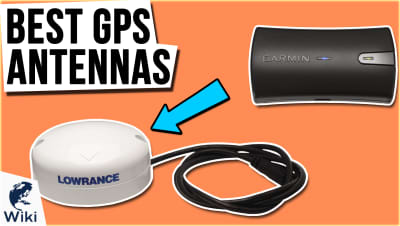The 10 Best AM/FM Car Antennas

This wiki has been updated 30 times since it was first published in January of 2018. Driving is no fun without music (or talk radio, if that's more your style), and having your favorite station suddenly become static puts a damper on any road trip. With these AM/FM car antennas, you can get great reception in any type of vehicle. Whether yours broke and you need a replacement, or you just want to upgrade the model you already have, one of these options will get you tuned in. When users buy our independently chosen editorial picks, we may earn commissions to help fund the Wiki.
Editor's Notes
March 12, 2021:
We're happy to report that all our previous selections remain very good choices for most consumers. The only real change made to the wiki this time was the elevation of the Keyo1e AP-23PC, because while it's not quite as aerodynamic as the AntennaMastsRus Shark Fin, the Keyo1e comes in a huge selection of specialized models that promise to fit perfectly on a wide variety of vehicles. If you're okay with getting your hands dirty, though, the Shark Fin remains a great choice.
November 26, 2019:
AM/FM antennas are relatively simple devices, but that doesn't mean they're all the same. Traditionally, they're about 31 inches long, similar to the Dorman Help! 76861 and Jensen HS519L, but advances in design and materials lets you get away with using a smaller module without sacrificing reception. The Bingfu Universal is one of the simplest such increases in technology thanks to its corkscrew design that increases the functional length without actually reaching a full 31 inches. The Dorman Help! 76866 and WMPHE 7-Inch (also available in 16 inches) cut that length considerably thanks to internal coils.
And they do get even smaller. On the very low end of the spectrum you'll find the AntennaMastsRus Shark Fin, which is exceptionally compact, and the Votex A010 and Keyo1e AP-24PC which are each only about 6 inches long. The Jensen JAN139 and UXCell Universal are notable because they feature internal coils and are rotatable upon installation so they'll fit on nearly any car, truck, or semi truck cab. And while you're at it, you may want to pick up a new stereo head unit and set of speakers to make the best of your increased range and reception.
The Original Wireless Technology
Widespread use of AM and FM radio continued, peaking in the 1970s, and recently seeing a huge drop-off in listeners due to digital radio and online streaming.
The year was 1894. Following in the pioneering footsteps of Heinrich Hertz — the first to conclusively prove the existence of electromagnetic waves — 20-year-old Guglielmo Marconi spent long nights working in his parents' Northern Italy attic. There, backed by his father's investment, he conducted a short-range telegraphy experiment that would slowly transform into the first commercially viable, long-range radio communications system. The young polymath adapted his wireless telegraph to transmit signals produced by the carbon microphone designs that Thomas Edison and Emile Berliner had invented. Widely considered the father of radio communications, Marconi would go on to perform the world's first transatlantic transmission in 1901.
Engineers spent the next 20 years developing radio technology robust enough for widespread use, and a large number of great minds contributed in different ways the 1920 birth of American radio broadcast. The initial focus was on amplitude modulation, which ended up the dominant form of mass communication for 30 years, until television's arrival. At that point, engineers turned to frequency modulation that allowed for much-increased sound quality.
Regardless of the modulation method, radio found its way quite quickly into that most American of inventions: the automobile. The first Motorola radio receiver was released in 1930 and quickly became standard in the upstart American car. Initial reactions were mixed, as some of the more cautious municipalities considered actual bans on car audio, citing distraction concerns. Benefits like weather information, traffic updates, and — obviously — on-the-go entertainment won out, and radio became a mainstay for decades. Now a popular company among automobile audiophiles, Blaupunkt sold the first consumer FM car stereos in 1952, though it was another 10 years before many stations would take advantage of the increased sound quality. Widespread use of AM and FM radio continued, peaking in the 1970s, and recently seeing a huge drop-off in listeners due to digital radio and online streaming. But the mark radio made on American culture is indelible, and believe it or not, there are still plenty of groovy tunes on the air today.
Hi-Fi Stereo Vs. The Long Ranger
Rarely has a format war ended so amicably.
It's also defined as the length of time from a wave's crest to its trough.
As recording quality had increased, it exposed the somewhat hollow nature of AM transmissions, resulting in the industry adoption of frequency modulation specifically for music. Amplitude is the distance from equilibrium to a wave's crest, also called its magnitude. Frequency operates on the other axis, representing in Hertz the number of times a signal cycles per second. It's also defined as the length of time from a wave's crest to its trough.
AM radio remains effective because it takes up a minimal portion of the available frequencies, and it offers a considerably longer range. It's used for talk shows and news radio, as well as the NOAA Weather Radio, which operates on lower frequencies than consumer units usually receive. Unfortunately, AM is also relatively susceptible to electromagnetic interference that can result from those very same weather emergencies.
FM radio has been the over-the-air choice for car audio since its adoption, simply because it transmits at a considerably higher resolution than AM. It's not affected much by the weather, although station range is generally quite shorter than that of AM radio. It also takes up a significantly wider swath of the overall frequency band, and it's been moved up or down the spectrum numerous times in the past to accommodate additions to federal radio band licensing. And, generally speaking, the same automobile antenna will pick up both types of transmission, so you certainly don't have to choose one over the other.
More Than Just Rabbit Ears
When Marconi raised his antenna up in the air, his system's range jumped immediately from a half-mile to almost five, and AM/FM antenna placement is just as important in receiving today's refined AM and FM transmissions as it was then. On-air music catalogs are more thorough and of higher fidelity than ever in history, and there is probably more news to listen to than ever before. If you can see the rust on the outside of your car's antenna, it's safe to say that the inside may not be functioning perfectly, either. For that matter, some drivers can't see their antenna at all — because it's not there anymore. Those drivers will need a replacement in order to enjoy the weekly top 40 on their next weekend road trip.
The body of a whip unit provides the rigidity as well as the reception.
The style found in cars for many decades is called a whip antenna. This straightforward design consists of a single unit of conductive metal that sticks straight up in the air. The body of a whip unit provides the rigidity as well as the reception. Newer vehicles tend to include antennas with considerably more aerodynamic, fin-like profiles, and it's easy to find aftermarket solutions shaped the same way. You'll find a lot of short, stubby models that claim to outperform the tall, flexible whips of decades past, and thanks to years of refinement, that's very often true. There are also a few interior-mounted antennas with slightly more complex designs. If you're dedicated to exploring far-off places, you may even consider adding a GPS antenna or cell booster to help you maintain connectivity in more remote areas.
Remember to also consider the installation process while choosing an AM/FM car antenna. Some will require new holes in body panels, and many owners are (rightfully) hesitant to undergo this kind of DIY task. If that sounds like you, keep an eye out for a model that can bolt directly to your previous antenna mount, or one that goes inside the cabin, because it's easier to affix an antenna to a protected interior.
The right AM/FM car antenna should fit your needs functionally, as well as physically. Whichever model you choose, you'll benefit from decades of impressive advancement in design, materials, and production techniques, so as long as they're still pumping out AM and FM radio, you'll be able to pick it up clearly.



